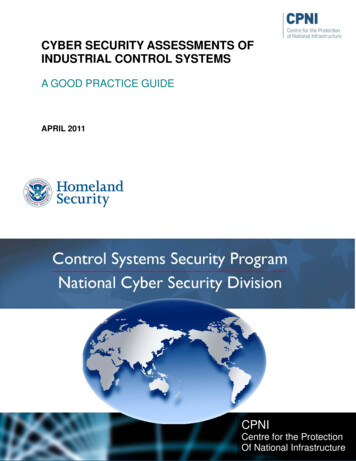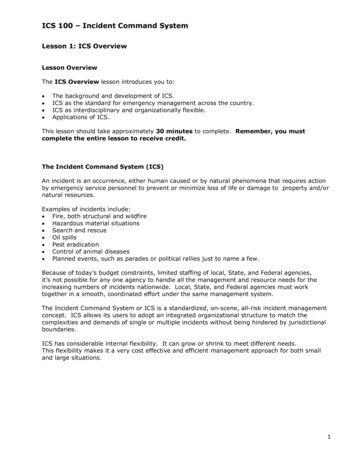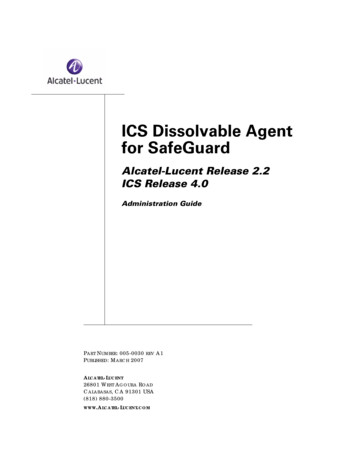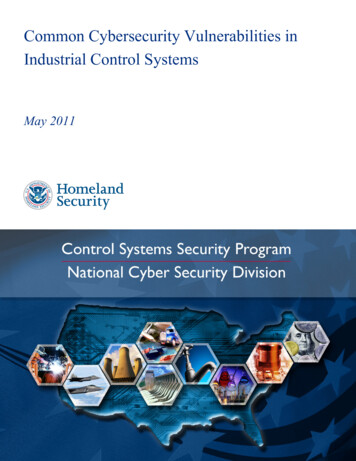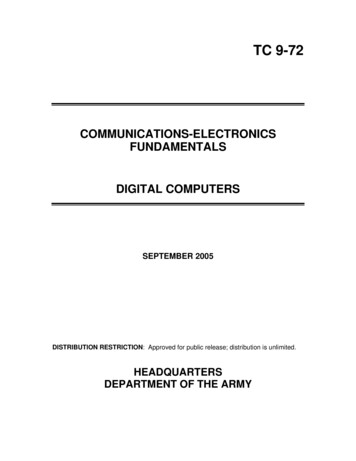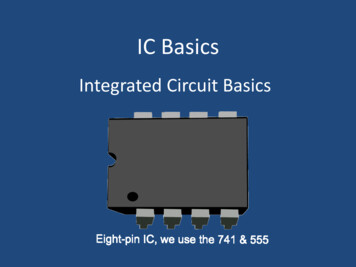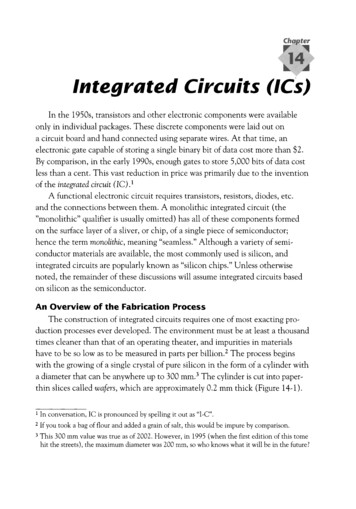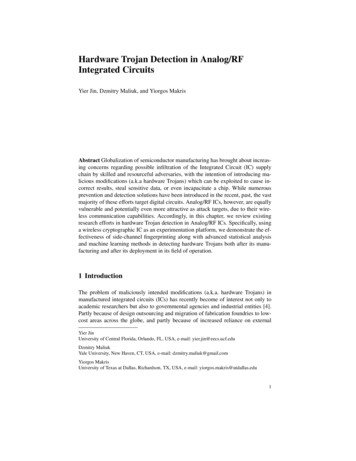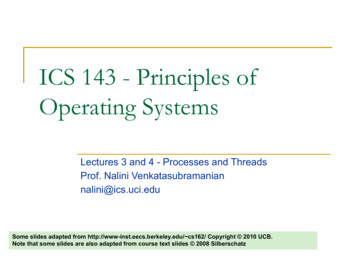
Transcription
ICS 143 - Principles ofOperating SystemsLectures 3 and 4 - Processes and ThreadsProf. Nalini Venkatasubramaniannalini@ics.uci.eduSome slides adapted from http://www-inst.eecs.berkeley.edu/ cs162/ Copyright 2010 UCB.Note that some slides are also adapted from course text slides 2008 Silberschatz
Outline Process Concept Process SchedulingOperations on ProcessesCooperating ProcessesThreadsInterprocess Communication
Process Concept An operating system executes a variety ofprograms Process - a program in execution batch systems - jobstime-shared systems - user programs or tasksJob, task and program used interchangeablyprocess execution proceeds in a sequential fashionA process contains program counter, stack and data section
Process ? Programmain (){main (){ ; ;}}A() {A() {Stack Program}ProcessMore to a process than just a program: Amain }HeapProgram is just part of the process stateI run Vim or Notepad on lectures.txt, you run it on homework.java – Sameprogram, different processesLess to a process than a program: A program can invoke more than one processA web browser launches multiple processes, e.g., one per tab
Process State A process changes state as it executes.newadmittedexitinterruptrunningreadyI/O oreventcompletionSchedulerdispatchwaitingI/O orevent waitterminated
Process States New - The process is being created.Running - Instructions are being executed.Waiting - Waiting for some event to occur.Ready - Waiting to be assigned to aprocessor.Terminated - Process has finished execution.
Process Control Block Contains informationassociated with each process Process State - e.g. new,ready, running etc.Process Number – Process IDProgram Counter - address ofnext instruction to be executedCPU registers - generalpurpose registers, stack pointeretc.CPU scheduling information process priority, pointerMemory Managementinformation - base/limitinformationAccounting information - timelimits, process numberI/O Status information - list ofI/O devices allocatedProcessControlBlock
Representation of Process SchedulingProcess (PCB) moves from queue to queueWhen does it move? Where? A scheduling decision
Process QueuesDeviceQueueReadyQueue
Ready Queue And Various I/ODevice Queues
Process Scheduling Queues Job Queue - set of all processes in the systemReady Queue - set of all processes residing in mainmemory, ready and waiting to execute.Device Queues - set of processes waiting for an I/Odevice.Process migration between the various queues.Queue Structures - typically linked list, circular listetc.
Enabling Concurrency and Protection:Multiplex processes Only one process (PCB) active at a time Current state of process held in PCB: Process needs CPU, resourcesGive out CPU time to different processes(Scheduling): “snapshot” of the execution and protection environmentOnly one process “running” at a timeGive more time to important processesGive pieces of resources to different processes(Protection): Controlled access to non-CPU resources E.g. Memory Mapping: Give each process their ownaddress spaceProcessControlBlock
Enabling Concurrency: Context Switch Task that switches CPU from one process toanother process Context-switch time is overhead the CPU must save the PCB state of the old process andload the saved PCB state of the new process.System does no useful work while switchingOverhead sets minimum practical switching time; canbecome a bottleneckTime for context switch is dependent onhardware support ( 1- 1000 microseconds).
CPU Switch From Process to Process Code executed in kernel above is overhead Overhead sets minimum practical switching time
Schedulers Long-term scheduler (or job scheduler) Short term scheduler (or CPU scheduler) selects which processes should be brought into the readyqueue.invoked very infrequently (seconds, minutes); may be slow.controls the degree of multiprogrammingselects which process should execute next and allocatesCPU.invoked very frequently (milliseconds) - must be very fastSometimes the only scheduler in the systemMedium Term Scheduler swaps out process temporarilybalances load for better throughput
Medium Term (Time-sharing)Scheduler
A tree of processes in Linux17
Process Profiles I/O bound process CPU bound process spends more time in I/O, short CPU bursts, CPUunderutilized.spends more time doing computations; few very long CPUbursts, I/O underutilized.The right job mix: Long term scheduler - admits jobs to keep load balancedbetween I/O and CPU bound processesMedium term scheduler – ensures the right mix (bysometimes swapping out jobs and resuming them later)
Process Creation Processes are created and deleteddynamicallyProcess which creates another process iscalled a parent process; the created processis called a child process.Result is a tree of processes e.g. UNIX - processes have dependencies and form ahierarchy.Resources required when creating process CPU time, files, memory, I/O devices etc.
UNIX Process Hierarchy
What does it take to create a process? Must construct new PCB Must set up new page tables for address space More expensiveCopy data from parent process? (Unix fork() ) InexpensiveSemantics of Unix fork() are that the child process gets acomplete copy of the parent memory and I/O stateOriginally very expensiveMuch less expensive with “copy on write”Copy I/O state (file handles, etc) Medium expense
Process Creation Resource sharing Execution Parent and children share all resources.Children share subset of parent’s resources - preventsmany processes from overloading the system.Parent and children share no resources.Parent and child execute concurrently.Parent waits until child has terminated.Address Space Child process is duplicate of parent process.Child process has a program loaded into it.
UNIX Process Creation Fork system call creates new processes execve system call is used after a fork toreplace the processes memory space with anew program.
Process Termination Process executes last statement and asksthe operating system to delete it (exit). Output data from child to parent (via wait).Process’ resources are deallocated by operating system.Parent may terminate execution of childprocesses. Child has exceeded allocated resources.Task assigned to child is no longer required.Parent is exiting OS does not allow child to continue if parent terminates Cascading termination
Threads Processes do not share resources well high context switching overheadIdea: Separate concurrency from protectionMultithreading: a single program made up of a number ofdifferent concurrent activitiesA thread (or lightweight process) basic unit of CPU utilization; it consists of: program counter, register set and stack spaceA thread shares the following with peer threads: code section, data section and OS resources (open files, signals)No protection between threadsCollectively called a task.Heavyweight process is a task with one thread.
Single and Multithreaded Processes Threads encapsulate concurrency: “Active” componentAddress spaces encapsulate protection: “Passive” part Keeps buggy program from trashing the system
Benefits Responsiveness Resource Sharing Economy Utilization of MP Architectures
Threads(Cont.) In a multiple threaded task, while one serverthread is blocked and waiting, a secondthread in the same task can run. Cooperation of multiple threads in the same job confershigher throughput and improved performance.Applications that require sharing a common buffer (i.e.producer-consumer) benefit from thread utilization.Threads provide a mechanism that allowssequential processes to make blockingsystem calls while also achieving parallelism.
Thread State State shared by all threads in process/addrspace Contents of memory (global variables, heap)I/O state (file system, network connections, etc)State “private” to each thread Kept in TCB Thread Control BlockCPU registers (including, program counter)Execution stack Parameters, Temporary variablesreturn PCs are kept while called procedures areexecuting
Threads (cont.) Thread context switch still requires a registerset switch, but no memory managementrelated work!!Thread states ready, blocked, running, terminatedThreads share CPU and only one thread canrun at a time.No protection among threads.
Examples: Multithreaded programs Embedded systems Most modern OS kernels Elevators, Planes, Medical systems, WristwatchesSingle Program, concurrent operationsInternally concurrent because have to deal withconcurrent requests by multiple usersBut no protection needed within kernelDatabase Servers Access to shared data by many concurrent users Also background utility processing must be done
More Examples: Multithreaded programs Network Servers Concurrent requests from networkAgain, single program, multiple concurrent operationsFile server, Web server, and airline reservation systemsParallel Programming (More than one physical CPU) Split program into multiple threads for parallelismThis is called Multiprocessing
# of addrspaces:OneManyOneMS/DOS, earlyMacintoshTraditional UNIXManyEmbedded systems(Geoworks, VxWorks,JavaOS,etc)JavaOS, Pilot(PC)Mach, OS/2, LinuxWindows 9x?Win NT to XP, Solaris,HP-UX, OS X# threadsPer AS:Real operating systems have either One or many address spacesOne or many threads per address space
Types of Threads Kernel-supported threadsUser-level threadsHybrid approach implements both user-leveland kernel-supported threads (Solaris 2).
Kernel Threads Supported by the Kernel Downside of kernel threads: a bit expensive Native threads supported directly by the kernelEvery thread can run or block independentlyOne process may have several threads waiting on different thingsNeed to make a crossing into kernel mode to scheduleExamples Windows XP/2000, Solaris, Linux,Tru64 UNIX,Mac OS X, Mach, OS/2
User Threads Supported above the kernel, via a set of library callsat the user level. Thread management done by user-level threads library May have several user threads per kernel threadUser threads may be scheduled non-premptively relative toeach other (only switch on yield())Advantages Cheap, Fast User program provides scheduler and thread packageThreads do not need to call OS and cause interrupts to kernelDisadv: If kernel is single threaded, system call from anythread can block the entire task.Example thread libraries: POSIX Pthreads, Win32 threads, Java threads
Multithreading Models Many-to-One One-to-One Many-to-Many
Many-to-One Many user-level threads mapped to singlekernel threadExamples: Solaris Green ThreadsGNU Portable Threads
One-to-One Each user-level thread maps to kernel threadExamples Windows NT/XP/2000; Linux; Solaris 9 and later
Many-to-Many Model Allows many user levelthreads to be mapped tomany kernel threadsAllows the operatingsystem to create asufficient number ofkernel threadsSolaris prior to version 9Windows NT/2000 withthe ThreadFiber package
Thread Support in Solaris 2 Solaris 2 is a version of UNIX with support for kernel and user level threads, symmetric multiprocessingand real-time scheduling.Lightweight Processes (LWP) intermediate between user and kernel level threadseach LWP is connected to exactly one kernel thread
Threads in Solaris 2
Threads in Solaris 2 Resource requirements of thread types Kernel Thread: small data structure and stack; threadswitching does not require changing memory accessinformation - relatively fast.Lightweight Process: PCB with register data, accountingand memory information - switching between LWP isrelatively slow.User-level thread: only needs stack and programcounter; no kernel involvement means fast switching.Kernel only sees the LWPs that support user-levelthreads.
Two-level Model Similar to M:M, except that it allows a userthread to be bound to kernel threadExamples IRIX, HP-UX, Tru64 UNIX, Solaris 8 and earlier
Threading Issues Semantics of fork() and exec() systemcallsThread cancellationSignal handlingThread poolsThread specific data
Multi( processing, programming, threading) Definitions: Multiprocessing Multiple CPUsMultiprogramming Multiple Jobs or ProcessesMultithreading Multiple threads per ProcessWhat does it mean to run two threads “concurrently”? Scheduler is free to run threads in any order and interleaving: FIFO, Random, Dispatcher can choose to run each thread to completion or time-slice in bigchunks or small chunksAMultiprocessingBCAMultiprogrammingABBCACBCB
Cooperating Processes Concurrent Processes can be Independent processes cannot affect or be affected by the execution of anotherprocess.Cooperating processes can affect or be affected by the execution of another process.Advantages of process cooperation: Information sharingComputation speedupModularityConvenience(e.g. editing, printing, compiling)Concurrent execution requires process communication and process synchronization
Interprocess Communication (IPC)Proc 1 Proc 3Separate address space isolates processes Proc 2High Creation/Memory Overhead; (Relatively) High Context-Switch OverheadMechanism for processes to communicate and synchronize actions. Via shared memory - Accomplished by mapping addresses to common DRAM Via Messaging system - processes communicate without resorting toshared variables. Read and Write through memorysend() and receive() messagesCan be used over the network!Messaging system and shared memory not mutually exclusive can be used simultaneously within a single OS or a single process.
Shared Memory CommunicationCodeDataHeapStackSharedProg 1VirtualAddressSpace 1 Data 2Stack 1Heap 1Code 1Stack 2Data 1Heap 2Code 2SharedCodeDataHeapStackSharedProg 2VirtualAddressSpace 2Communication occurs by “simply” reading/writing to sharedaddress page Really low overhead communicationIntroduces complex synchronization problems
Cooperating Processes via MessagePassing IPC facility provides two operations.send(message) - message size can be fixed or variablereceive(message) If processes P and Q wish to communicate, theyneed to: establish a communication link between themexchange messages via send/receiveFixed vs. Variable size message Fixed message size - straightforward physical implementation,programming task is difficult due to fragmentationVariable message size - simpler programming, more complexphysical implementation.
Implementation QuestionsHow are links established? Can a link be associated with more than 2processes? How many links can there be between every pairof communicating processes? What is the capacity of a link? Fixed or variable size messages? Unidirectional or bidirectional links? .
Direct Communication Sender and Receiver processes must nameeach other explicitly: send(P, message) - send a message to process Preceive(Q, message) - receive a message from process QProperties of communication link: Links are established automatically.A link is associated with exactly one pair of communicatingprocesses.Exactly one link between each pair.Link may be unidirectional, usually bidirectional.
Indirect Communication Messages are directed to and received frommailboxes (also called ports) Unique ID for every mailbox.Processes can communicate only if they share a mailbox.Send(A, message) /* send message to mailbox A */Receive(A, message) /* receive message from mailbox A */Properties of communication link Link established only if processes share a common mailbox.Link can be associated with many processes.Pair of processes may share several communication linksLinks may be unidirectional or bidirectional
Indirect Communication usingmailboxes
Mailboxes (cont.) Operations Issue: Mailbox sharing create a new mailboxsend/receive messages through mailboxdestroy a mailboxP1, P2 and P3 share mailbox A.P1 sends message, P2 and P3 receive who getsmessage?Possible Solutions disallow links between more than 2 processesallow only one process at a time to execute receive operationallow system to arbitrarily select receiver and then notifysender.
Message Buffering Link has some capacity - determine thenumber of messages that can residetemporarily in it.Queue of messages attached to link Zero-capacity Queues: 0 messages sender waits for receiver (synchronization is calledrendezvous)Bounded capacity Queues: Finite length of n messages sender waits if link is fullUnbounded capacity Queues: Infinite queue length sender never waits
Message Problems - ExceptionConditions Process Termination Problem: P(sender) terminates, Q(receiver) blocks forever. Solutions: System terminates Q. System notifies Q that P has terminated. Q has an internal mechanism(timer) that determines how long to waitfor a message from P.Problem: P(sender) sends message, Q(receiver) terminates.In automatic buffering, P sends message until buffer is full orforever. In no-buffering scheme, P blocks forever. Solutions: System notifies P System terminates P P and Q use acknowledgement with timeout
Message Problems - ExceptionConditions Lost Messages OS guarantees retransmissionsender is responsible for detecting it using timeoutssender gets an exceptionScrambled Messages Message arrives from sender P to receiver Q, butinformation in message is corrupted due to noise incommunication channel.Solution need error detection mechanism, e.g. CHECKSUM need error correction mechanism, e.g. retransmission
Producer-Consumer Problem Paradigm for cooperating processes; producer process produces information that isconsumed by a consumer process.We need buffer of items that can be filled byproducer and emptied by consumer. Unbounded-buffer places no practical limit on the size ofthe buffer. Consumer may wait, producer never waits.Bounded-buffer assumes that there is a fixed buffer size.Consumer waits for new item, producer waits if buffer is full.Producer and Consumer must synchronize.
Producer-Consumer Problem
Bounded Buffer using IPC(messaging) Producerrepeat produce an item in nextp; send(consumer, nextp);until false; Consumerrepeatreceive(producer, nextc); consume item from nextc; until false;
Bounded-buffer - Shared MemorySolution Shared datavar n;type item .;var buffer: array[0.n-1] of item;in, out: 0.n-1;in : 0; out: 0; /* shared buffer circular array *//* Buffer empty if in out *//* Buffer full if (in 1) mod n out *//* noop means ‘do nothing’ */
Bounded Buffer - Shared MemorySolution Producer process - creates filled buffersrepeat produce an item in nextp while in 1 mod n out do noop;buffer[in] : nextp;in : in 1 mod n;until false;
Bounded Buffer - Shared MemorySolution Consumer process - Empties filled buffersrepeatwhile in out do noop;nextc : buffer[out] ;out: out 1 mod n; consume the next item in nextc until false
An operating system executes a variety of programs batch systems - jobs time-shared systems - user programs or tasks Job, task and program used interchangeably Process - a program in execution process execution proceeds in a sequential fashion A
